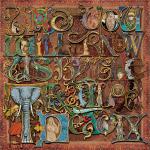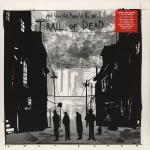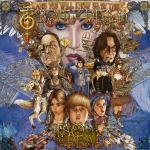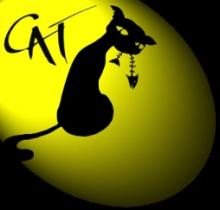...And You Will Know Us By The Trail Of Dead
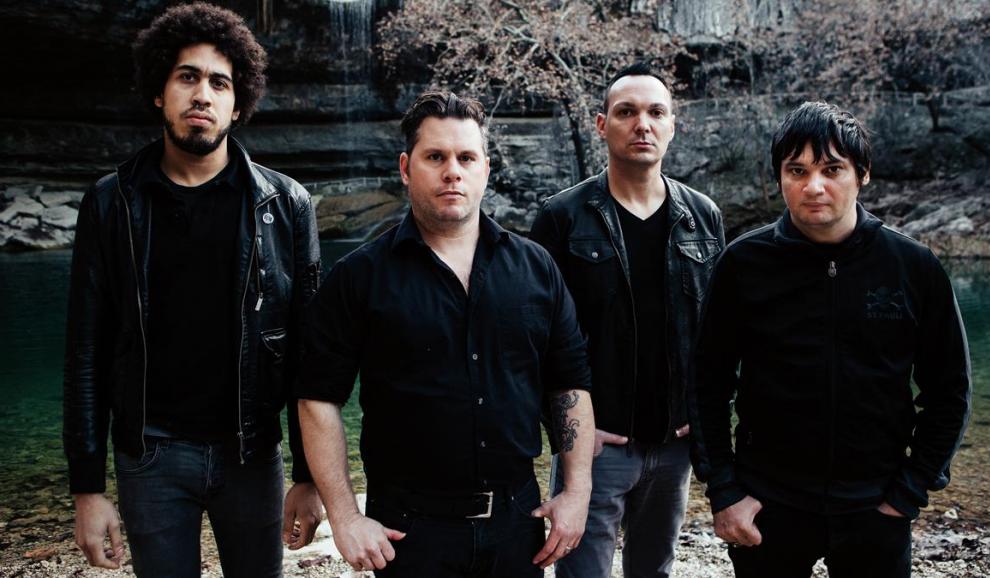 Biografie
Biografie
When one takes the time to step back from the extraneous noise of modern radio music and ask the question as to where it is all leading to, one might get the sense of hundreds of thousands of tiny arteries speeding away from a distant central vein. The trends of current European dance music are such that genres seem to crop up faster than we are capable of finding names for them. And yet one might also get a sense that these tiny sub-genres we have created really sound more alike than different, at least to the unaccustomed ear (and that would mean most of us). Have we come to a point where naming each variation is more important than recognizing the theme? Indeed, what is the steam driving the engine that is churning out the myriad of variations, and could they fundamentally be based at all upon the machination of technology that created them? In the end, many modern thinkers (so-called because a trendy sense of false modesty stops them from calling themselves philosophers) wonder if we have become a society that creates technology faster than it can learn to use it, whose ability to offer the average consumer choices has far outpaced the consumer’s capacity for judgment and taste. We are now more than ever gadget collectors, but long gone is the age of the enlightened amateur.
In order that we may appreciate this growing sense of rapid and disorienting change which is inherent in current Western music it may help to form a basic understanding of what developments, both technological and ideological, have caused it to reach this fragmented point. Western music for the last thousand years has been marked by constant stylistic change. Unlike the classical forms of other world cultures and civilizations whose emphasis is often placed upon stasis, ritual and rigid traditionalism, Western music has had as its motivating force the idea of progress and development which appears to have run concurrently to great cumulative leaps in technological development. Nowhere can this be seen better illustrated than the 20th century itself. Would it not therefore be possible to postulate that modern music will continue to evolve along with and at the same rate as modern technology, and that our current tastes will change and fragment as rapidly as our computer processors improve in speed and their hard drives increase in size? To get a sense of these changes, let us take a brief tour through this technological history, and for those of you who are unfamiliar with music history we shall start with a simple definition.
Music has been defined as sound organized through time (one might write the equation M=st). Records of Western music before the high-middle ages is unfortunately a scant one; only forty or so fragments of music still exist from that time period spanning thousands of years which we call the Ancient world, the oldest known of these being a fragment of a chorus from Orestes by the Greek playwright Euripides (who apparently not only wrote and directed his plays but composed the choruses as well). To our ears this disjointed, rather oriental-sounding work of monophony might seem a little tuneless, but it is important to keep in mind that at this point “tune” had not yet been invented, and our modern harmonic understanding would be many centuries in the making (as we shall see). However the basic Greek musical ideal would steer European music on its course for centuries to come. Consider our tonal modes – Aolean, Phrygian, Mixolydian, etc. – which still bear the names of their Greek origin; or even our word for music, deriving from the Greek muses, those nine goddesses who gave mankind divine creative inspiration. But more importantly the concepts that all music stemmed from the work of a greater divinity, that it illustrated a cosmic harmony capable of being understood through science and geometry, and that it had at its root a higher mathematical as well as spiritual significance – these ideals would not only set the basis for music’s role in the early Christian church, but in Western society itself.
Arguably the most valuable development of this time was made by Pythagoras, the famed mathematician who was him-self not a musician. Pythagoras is accredited with single-handedly inventing music theory when he discovered the correlation between mathematical ratios and harmonic intervals. It is said that upon his hearing a blacksmith working with different weighted hammers which created tones of related harmonic intervals he began experimenting with weights and strings to make this remarkable discovery – the division of a string by exactly half will create the interval of an octave; by one third will create the interval we know as a perfect fifth (from C to G); and by one forth, the interval known as a fourth (from C to F). One might consider that by this observation music, like mathematics, is a universal absolute, in which case advanced aliens would have already discovered rock and roll long before having discovered Earth.
It is during the Dark Ages that we in the West begin to develop methods of writing (and thus recording) music. These monophonic plain-chants of the early Christian church (commonly known as Gregorian chant in honor of Pope Gregory I (540-604 C.E.) who standardized the Church’s liturgical procedures), like the technology of the Dark Ages was slow to develop, and like other world music its purpose was primarily for religious ritual. However the changing climates in Europe during the High middle ages that would eventually see great rises in population and the formation of cities also helped to influence the rise of music of a more secular nature. Composers such as Leonin (1159-1201) of the Ars Antiqua in Paris – incidentally the first composer’s name we have on written music – began advantage of these changes in attitudes to develop polyphonic works – works of two or more melodies. It was in calculating the relationships of adjacent intervals of these melodies that Western composers begin to develop the idea of harmony. This wonderful double-edged sword would actually yield two fruit, for by creating the idea of harmony, one also must acknowledge dissonance, which became an extremely effective tool in the modern era of static and traffic. It would still be several hundred years and many developments later, however, before the rules for this would eventually be worked out, and the troubadours of this time would suffice to sing their madrigals ignorant of it.
It is to the unlikely role of the Protestant Reformation that we arguably owe the emergence of Pop Music. Martin Luther, a man of great religious conviction, was also a great lover of music who, far from being the repressed Protestant preacher we might associate with Footloose, believed that music was meant to taken out of the choir-boy pews and be sung by the entire congregation. This led to the development of the Protestant hymn, an easily-learned, melodic song which could be taken up by just about anybody with a voice and a hymnal. Along with great advances in harmonic theory the stage was set for the Baroque era, which many people see as the starting point of Classical music. It should also be remembered that the development of the printing press in the mid-1400’s by Johannes Gutenberg further helped to spread written music throughout Europe. One also cannot say enough (in half of an extremely inadequate paragraph) about the development of opera in 1600. It is this sublime Italian combination of dramatic text (libretto) set to music – originally conceived, incidentally, with the help of Vincenzo Galilei, father of famed astronomer Galileo, as a revitalization of the Greek ideal of music accompanying theatre – that would greatly define the pinnacle of Western music from that time on. Although pages could be written about opera’s influence on our perception of entertainment itself, the music video, Broadway (and Hollywood) musicals, the arena-rock concert and the Superbowl half-time show are only a few examples of its lasting influence upon our popular culture.
We now come to two key developments whose evolutions are so closely interconnected so as to be almost inseparable, and whose dissemination in our culture is so complete that it necessitates pointing out for people to even notice them – the invention of the piano forte and Even Musical Temperament. For those musically illiterate among you, allow yourself time to breathe but let it be one of relief rather than dread for these topics are not nearly as daunting as they might sound.
Up until this point the favored instrument of composition had been the harpsichord, a plucked instrument incapable of any dynamic gradation – either you were loud, or you were soft. In 1709 an Italian in the employment of Ferdinando de Medici named Bartolomeo Cristofori drew up plans for what he simply called gravicembalo col piano e forte, or the “big harpsichord with soft and loud” (our modern word for piano simply means soft), an instrument whose strings were struck by a balanced hammer mechanism rather than a plucked by a plectrum. The gradients in dynamic expressivity afforded by this allowed composers to write works of an emotional content hitherto unimagined, and consequently ushered in the Classical period. This new-found emphasis on musical expressivity would eventually lead to Beethoven and the Romantic era, a period in which music (and art) finally began to be seen as acts of personal expression rather than ones of religious devotion or duty to a head of state. The idea of music as self-expression is also so permeating an ideal of our modern culture that it is difficult to think of it as anything else, however you might say we have Crostofori’s big harpsichord to thank for this.
By comparison the solution of musical temperament has often taken the backseat alongside such grandiose developments as opera and the piano-forte, perhaps rightly so as it continues to be an on-going argument to this day. That our modern tuning system is actually “out of tune” is not apparent to the average listener. Unfortunately, like finally seeing the animal-shape in an abstract computer-generated pattern, once you’ve noticed it you will always notice it. Simply put, sometime in the mid-1800’s it was decided to make the intervals between notes on the piano of a perfectly even from one another – a C# would be perfectly in-between C and D. That this so completely obvious to a modern musician is an illustration of how much we’ve embraced this idea. However prior to this even-tuning, or Even-Temperament as it is known, a piano was restricted to playing in certain keys, mainly keys such as C with little or no accidentals. Transpose a piece to, say, the key of B and you were in for some discordant trouble. To understand the reason for this would take more explaining and mathematical diagrams than I have time for, but suffice it to say the tuning method invented by Pythagoras was not as divinely perfect as we had hoped. To compensate for this it was decided to tune all the notes on a piano except for the octave a little out of tune, but not out of tune enough for the general public to notice. The result was our new-found ability to play fearlessly in any key, and lo! we have jazz. But at what price? Well it may be too early to say, but it has been postulated that we children of the modern age are so used to hearing music out of tune that we simply no longer take true pitches into our consideration, and have perhaps lost one of the great beauties of harmonic balance for eternity. And listening to modern rock radio would certainly attest to that.
To summarize the many stages of development which led to our modern era in so brief a space is next to impossible. We miss out on the perfection of the valve system for horns and winds, the evolution of the lute into the guitar, the development of the musical virtuoso, and subsequently the sonata form; even the invention of the saxophone. But it is necessary to skip all these wonderful details in order to focus on one single great development which perhaps signaled beginning of the end of pure music – the invention of recorded music. It is perhaps more than anything our ability to not have to leave our beds, let alone our chairs or living rooms, in order to hear music or have it played for us. Before the phonograph there were concerts, and then there was the amateur – that person who didn’t have to be great at what they did, but did it because they loved it. Could you even imagine that in order to hear your favorite Beatles song you would have to go to a piano and play it? No, because to our modern minds the artist and their recording is inseparable. If you hear someone playing Hey Jude in a piano bar, you’re not really hearing Hey Jude! No, you would have to hear played back that noise-shadow imprinted onto plastic by George Martin of the Beatles performing Hey Jude in 1969 at Abbey Road studios – that is Hey Jude. Anything else is simply an inept cover, even if it were the Beatles covering it themselves!
This association of music with a recording rather than a live performance, along with the loss of the average listener to be capable of playing the music they want to listen to and the absence of a piano in every average middle-class household, is probably the most defining aspect of our less-than-definitive musical age. No, it is not the atrocious-sounding electric guitar, no it isn’t those annoying drum machines, no, not those synthesizers that are impossible to comprehend or even those computers you see everywhere these days. Rather, the demise of our need to work for music, to have a certain affinity to it, whether it be seeing it performed for us by apt musicians or listening to a family member reading it out of a song book, which makes us the consummate insatiable consumer and gives way our need for more and more choice and diversity. Like a glutton who has overstuffed themselves past the point which their stomach-linings have bloated outward, so our musical-ears are overstuffed with variations without ever paying attention to theme, obsessed with consumption without any focus on merit. And we will continue to break off chunks of the pure form and dilute it with any whim available simply because it is available, for there is no longer any actual activity associated with our ability to appreciate.
There is only one last major development to mention, and I’m sure that for those stalwart defenders of rock music it is the only one worthy of consideration – the creation of electric instruments. Whether this is actually a development or simply a conclusion we may be too close inside to actually determine. As we are speaking of something concurrent to the present, when everyone who owns a Macintosh has a virtual recording studio and the idea of an Enlightened Amateur may slowly be being resurrected, we cannot perceive it with objectivity or purity of understanding and so are best leaving that to our grandchildren.
Quelle: http://www.trailofdead.com/Discografie2014 IX
2012 Lost Songs
2011 Tao Of The Dead
2009 The Century Of Self
2008 Festival Thyme EP
2006 So Divided
2004 Worlds Apart
2003 The Secret Of Elena's Tomb EP
2002 Source Tags & Codes
2001 Relative Ways EP
1999 Madonna
1998 ...And You Will Know Us By The Trail Of Dead
www


